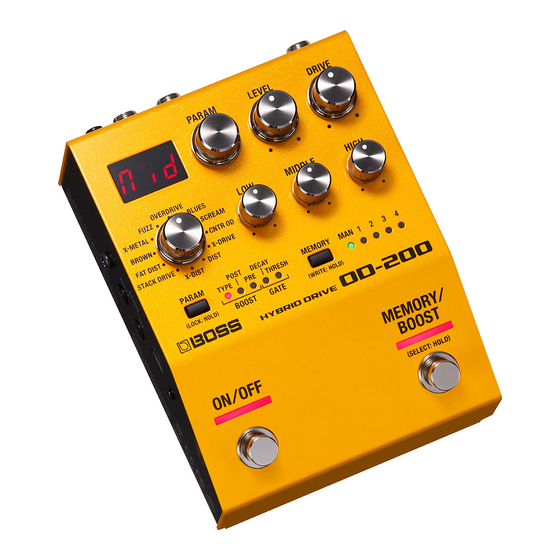
Table of Contents
Advertisement
Advertisement
Table of Contents

Summary of Contents for Roland BOSS OD-200
- Page 1 Before using this unit, carefully read “USING THE UNIT SAFELY” and “IMPORTANT NOTES” (the leaflet “USING THE UNIT SAFELY” and the Owner’s Manual (p. 16)). After reading, keep the document(s) where it will be available for immediate reference. © 2019 Roland Corporation...
-
Page 2: Panel Descriptions
Panel Descriptions Top Panel Display Shows the parameters and the values. [PARAM] knob Adjusts the parameter that is selected by the [PARAM] button, or switches memories. [LEVEL] knob Adjusts the volume of the effect sound. [DRIVE] knob Adjusts the depth of distortion. Mode knob Selects the sound. - Page 3 Panel Descriptions Mode Explanation [PARAM] button Overdrive that uses MDP to provide ideal Selects the parameter that is adjusted by the [PARAM] (X-DRIVE) distortion in each frequency region. knob, or switches memories. This gives a basic, traditional distortion sound. (DIST) Parameter Explanation Distortion that uses MDP to provide ideal...
- Page 4 Panel Descriptions You can also select a parameter or memory by pressing Parameter Explanation the [PARAM] knob. This is a distortion that (X-DIST) uses MDP to obtain the distortion About the booster that’s most appropriate in each pitch range. As its main distortion, the OD-200 provides 12 different types of sound.
-
Page 5: Memory Button
Panel Descriptions Parameter Explanation BOOST/GATE indicator [LOW] [MIDDLE] Adjust the tonal character of the main Indicates the parameter that can be adjusted by the [HIGH] knobs distortion. [PARAM] knob. When STRUCTURE is PARALLEL When the indicator is unlit, the knob selects memories. The booster and main distortion are placed in parallel. -
Page 6: Input Jack
Panel Descriptions [MEMORY/BOOST] switch INPUT jack Switches memories (p. 8). Connect your guitar, bass, or effect unit here. Long-press the [MEMORY/BOOST] switch to turn the Turning On/Off the Power booster on/off. The INPUT jack also operates as the power switch. The MEMO power turns on when you insert a plug into the INPUT jack. -
Page 7: Midi Jacks
Using the jack as EXP (Connecting Your Equipment) You can connect an expression pedal (sold separately: EV-30, Roland EV-5, etc.) and use it to control the amount of boost or the volume of the effect sound (p. 11). * Use only the specified expression pedal. By connecting any other expression pedals, you risk causing malfunction and/or damage to the unit. -
Page 8: Saving To Memory
Saving and Switching Memories Saving to Memory Switching Memories Here's how to save effect settings that you edited. Here’s how to recall a saved memory. Long-press the [MEMORY] button. Press the [MEMORY] button to select a memory. The display indicates “Wrt. ” Each time you press the button, you cycle through Turn the [PARAM] knob to select the save- the memories in the order of “MAN (manual) 0 1... -
Page 9: Basic Operation
Overall Settings (Menu) Assigning functions to external pedals Basic Operation You can connect a footswitch (sold separately: FS-5U, FS-6, FS-7) to Press the [PARAM] button and [MEMORY] the CTL 1, 2/EXP jack, and use it to switch the booster on/off or to change memories. - Page 10 Overall Settings (Menu) Parameter Explanation Menu Parameter List Specify the functions of the [ON/OFF] switch, [MEMORY/BOOST] switch, and About the mark MEMORY MEMORY footswitches connected to the CTL 1, 2/ MEMORY MEMORY EXP jack. (ON/OFF SWITCH 5 Can be set and saved for each memory by the “Saving to Memory” (p. FUNCTION) * The functions that can be assigned differ 8) operation.
- Page 11 Overall Settings (Menu) Parameter Explanation Parameter Explanation Specifies the function of an expression pedal connected to the CTL 1, 2/EXP jack. (ON/OFF SWITCH FUNCTION PREFERENCE) No operation. oFF: The same operation as the (DRIVE) [DRIVE] knob. (MEMORY SWITCH FUNCTION PREFERENCE) The same operation as the (LEVEL) The setting in memory is used.
- Page 12 Overall Settings (Menu) Parameter Explanation Parameter Explanation Specifies whether program changes are (DRIVE CC) (PC IN) received (on) or not received (oFF). Specifies whether program changes (LEVEL CC) are transmitted (on) or not transmitted (oFF). (LOW CC) Correspondence between memories and program numbers (MIDDLE CC) (PC OUT)
- Page 13 Overall Settings (Menu) Parameter Explanation Specifies whether MIDI messages received at the MIDI IN connector are retransmitted without change from the MIDI OUT (MIDI THRU) connector (on) or are not retransmitted (oFF). P1–Pg Specify the memory corresponding to the (P1–P9) received program number.
-
Page 14: Returning To The Factory Settings
Appendix Returning to the Factory Settings Installing Batteries (Factory Reset) Here’s how to return the OD-200 to its factory-set state. Insert the batteries as shown below, being careful to orient the batteries correctly. While holding down the [ON/OFF] switch and * Batteries should always be installed or [MEMORY/BOOST] switch, turn on the power replaced before connecting any other... -
Page 15: Attaching The Rubber Feet
Dual footswitch: FS-6, FS-7 Expression pedal: FV-500H, FV-500L, EV-30, Roland EV-5 MIDI/TRS connecting cable: BMIDI-5-35 * This document explains the specifications of the product at the time that the document was issued. For the latest information, refer to the Roland website. -
Page 16: Using The Unit Safely/Important Notes
• Roland assumes no liability concerning the restoration of any stored content that has been lost. • Do not use connection cables that contain a built-in... - Page 17 Licensed under the Apache License, Version 2.0 (the “License”); You may obtain a copy of the License at http://www.apache.org/licenses/LICENSE-2.0 • Roland, BOSS are either registered trademarks or trademarks of Roland Corporation in the United States and/or other countries. • Company names and product names appearing in this document are registered trademarks or trademarks of their respective owners.













Need help?
Do you have a question about the BOSS OD-200 and is the answer not in the manual?
Questions and answers